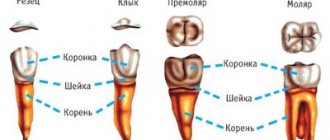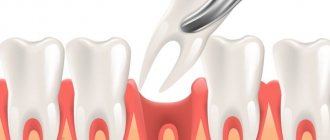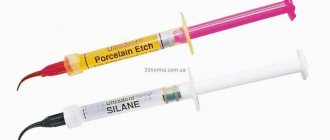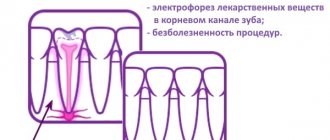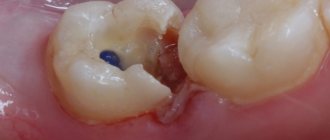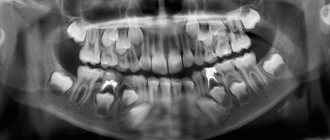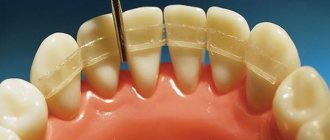We identify the causes of toothache
The unpleasant sensations associated with caries or gum inflammation are probably familiar to many. But do teeth hurt with neuralgia? It turns out that nerve endings can also become inflamed and cause aching, shooting or paroxysmal pain. The specific location of the three branches of the trigeminal nerve contributes to the spread of pain to the lower and upper jaw, as well as the upper part of the face.
If you have toothache, inflammation of the trigeminal nerve may be the root cause of these unpleasant sensations. At home, you can only assume the presence of such a disease. The final verdict on the cause of pain is made only by the dentist.
Going to the dentist is the best solution for this pathology
We tell you what to do if the nerve of the tooth is exposed. The doctor will help you get rid of not only painful symptoms, but also the problem itself that provokes them.
On a note! If you have an exposed tooth nerve, then before understanding how to treat, the doctor will use a visual examination and x-ray to determine the extent of the damage.
Conservative (biological) treatment method with pulp preservation
In case of an inflammatory process that has slightly affected the pulp, and in the absence of negative changes in the periodontal tissues, conservative therapy with preservation of the nerve is possible. In this case, the specialist will simply clean the root canals and put medications with calcium hydroxide inside and install a temporary filling. Next, dynamic observation is carried out. In case of positive dynamics, the temporary filling is replaced with a permanent one. From the first visit to the clinic to the final one it can take from several weeks to 6 months.
Surgical methods
In most cases, the pulp is severely inflamed because it has time to be exposed to harmful bacteria while you are wondering whether to go to the doctor or wait a little and be patient. In this case, the specialist, as a rule, decides to remove it partially (vital amputation) or completely (extirpation).
Most often, the nerve is completely removed. But the procedure for killing it and removing it from the tooth cavity can be carried out in different ways. The most modern - vital extirpation, that is, the living pulp is removed - is performed in one visit to the dental office, under local anesthesia, using special tools - files and pulp extractors.
However, many clinics still practice treatment in two stages. If a tooth hurts or a nerve is exposed, this is what the doctor will do:
- at the first stage: the specialist drills out hard tissues, opens access to the root canals, puts a special devitalizing paste inside and closes the cavity with a temporary filling. Some pastes contain arsenic, but they are less toxic and safer than those used previously, and also contain lidocaine for pain relief and antiseptics. Killing of the pulp usually occurs within 1-3 days. Also today, in some clinics, arsenic-free formulations are used for these purposes, which are considered even safer - these can remain in the mouth for up to 10 days,
- at the second appointment: the temporary filling and paste are removed, the dead pulp is removed, the tissues and canals are well cleaned, and a permanent filling is placed. X-ray control is required, with the help of which the doctor can evaluate the quality of the work done and make sure that the pulp is completely removed.
“I faced unbearable pain due to an exposed nerve. The pills did not help relieve the pain at all. The clinic immediately offered to remove the pulp and then put a crown on top. Otherwise, they said, the tooth will not last long in this condition. They removed the pulp in one sitting, immediately put on a temporary crown, and 2 weeks later - a permanent one.”
Ris, review from yell.ru
The main symptoms of inflammation of the ternary nerve
What are the main symptoms of trigeminal nerve inflammation and tooth pain? The location of the pain and its nature will depend on which nerve endings are inflamed. If it is the lower trigeminal nerve, then discomfort will be felt in the lower jaw. With inflammation of the middle trigeminal nerve - in the upper jaw. Inflammation of the superior trigeminal nerve causes pain to spread to the upper part of the face (eyes, forehead, temples and even ears).
With neuralgia, teeth can hurt either constantly or periodically (paroxysmal pain). Unpleasant sensations can begin suddenly and end just as unexpectedly. Sometimes it can be very difficult to identify the exact location of pain.
How do teeth hurt with trigeminal neuralgia? Discomfort can manifest itself as ordinary toothache or migraine. But, characteristically, this pathology never causes edema.
Radiation diagnostics
Of course, CBCT of the area of the impacted tooth provides the most complete three-dimensional picture of the position of the nerve and tooth. It is important to note here that any such examination must be supported by a written description from the radiologist. In this case, the surgeon has legal protection in case of a conflict situation and a lawsuit. The description must indicate the likelihood of such an injury: “the root of the tooth is adjacent to the wall of the mandibular canal,” “damage to the joint canal is possible when the tooth is removed,” “a narrowing of the canal at the level of the impacted tooth is detected.” OPTG is a more outdated research method; in the image it is not always possible to assess the location of the mandibular canal, especially in the buccolingual aspect. However, this classical diagnostic method is still widely used. A radiological sign of the contact location of the nerve and tooth is the following criteria: absence of the mandibular cortical plate at the level of the impacted tooth, narrowing of the lumen of the mandibular canal at the level of the tooth (Fig. 3,4). From a practical point of view, CBCT does not provide significant advantages and does not reduce the risk of developing paresthesia when removing an impacted tooth, since the extraction process is not computer-guided.
Prevention of complications. Before surgery to remove an impacted tooth, it is necessary to inform the patient about the possible risks of damage to the inferior alveolar nerve. It is important to convey to the patient that the timing of restoration of sensitivity of the lower lip depends on many factors and it is impossible to indicate the exact recovery time. The patient must be informed for what reasons the tooth is being removed; it is important to have a written description of the position of the tooth by the radiologist and a written opinion from the orthodontist. All this data must be attached to the patient’s medical record, and only after reviewing and signing the voluntary medical intervention can you begin to work with the patient.
Rice. 3. Narrowing of the lumen of the mandibular canal on OPTG is a sign of the anatomical proximity of the tooth root and the lower alveolar nerve.
Rice. 4. Darkening of the cortical pattern of the mandibular canal on OPTG is a sign of the anatomical proximity of the tooth root and the inferior alveolar nerve. After the tooth was removed, an open vascular nerve bundle was visible in the wound.
The technique of removing an impacted tooth requires sufficient lighting and good visualization of the surgical field. It is necessary to carry out a wide opening of the wound with skeletonized alveolar part at the level of the second molar and retromolar fossa and partially the branch. Small access significantly complicates the view of the wound. In most cases, tooth extraction begins with freeing the crown from the adjacent bone, then sawing the tooth along the dentino-enamel junction with a drill. After removing the crown and tooth, work is carried out on the roots. Based on the shape of the tooth cavity and the position of the orifices, the bifurcation of the roots is determined, and the roots are separated using a drill. When removing a single-rooted third molar, the socket is expanded on the side opposite to the position of the nerve (in most cases, on the buccal side). Root luxation with an elevator must be carried out without strong pressure, because a root fracture in the apical third with its subsequent removal increases the risk of nerve injury. In some cases, it is advisable to leave the tooth root in the wound as a “foreign body” in order to prevent nerve injury. The root fragment does not complicate wound healing, since the tooth does not have an apical infection. It is important to inform the patient that the tooth root “must be left” in order to preserve the integrity of the surrounding structures. Abroad, there is a generally accepted method for preventing nerve injury during tooth extraction - coronectomy, in which only the crown part of the tooth is removed. In fact, this removal can be considered incomplete. The root of an impacted tooth moves coronally over time, and bone tissue forms between the tooth and the mandibular canal. The second stage involves removing the roots of the tooth. This technique is not prescribed in domestic standards for the treatment of pericoronitis and is not described in the national guidelines, therefore it cannot be recommended for use in the Russian Federation.
How is trigeminal nerve inflammation diagnosed?
If you only feel aching pain in your teeth, then first you need to make an appointment at a dental clinic. Only a competent dentist can determine the nature of the pain, its cause and the exact source. Typically, an examination of the oral cavity is performed, followed by palpation and tapping of painful areas. To accurately verify the neuralgic nature of the disease, you will need to undergo a CT scan of the teeth (this will show the presence of inflammatory processes in the teeth and gums, and will also allow you to detect abscesses and other pathologies). You may need to consult an ENT specialist, since problems with the maxillary sinuses may also cause pain. Well, if you experience characteristic shooting pains, you should immediately contact a neurologist.
Once the presence of tertiary nerve inflammation is confirmed, the doctor decides how to treat the patient. You should not hope that the pain will go away on its own. These cases are extremely rare; moreover, it is important to determine the true cause of the discomfort and exclude other more dangerous and serious pathologies.
Causes of pathology
Could the most sensitive part of the tooth be exposed? Yes, access to it opens when hard tissues are destroyed, which most often happens due to untreated caries. First, bacteria and their metabolic products corrode the enamel-dentin layer, forming a large cavity. And then they penetrate into the pulp through the dentinal tubules[1], causing inflammation and provoking pulpitis, periodontitis and other more severe complications, for example, periostitis, abscess. Sometimes the pulp is exposed under the influence of directed mechanical force, injuries and blows received in the area of the maxillofacial apparatus.
On a note! Some complain about exposed dental nerves and are interested in how to relieve pain that occurs from cold, sour, sweet and hot foods, or mechanical stress. This pain is of a sharp, short-term nature. In fact, in this case, we are most often not talking about caries and pulpitis, but about such a phenomenon as enamel hyperesthesia.
How is inflammation of the trigeminal nerve treated?
Correct treatment for inflammation of the trigeminal nerve can only be prescribed by a neurologist. Depending on the complexity of inflammation, the following agents are included in therapy:
- Drugs to combat symptoms (pain);
- Antispasmodics and muscle relaxants of central action;
- Alcohol blockades (for severe inflammation);
- Metabolic drugs;
- Anticonvulsants (carbamazepine, finlepsin);
- B vitamins;
- Physiotherapeutic procedures.
The measures are aimed at relieving inflammation and completely eliminating pain symptoms. Properly prescribed treatment for inflammation of the trigeminal nerve can not only restore excellent health, but also prevent relapses.
This information is for informational purposes only. Only a professional specialist can prescribe treatment after examination and diagnosis.
Removing the nerves of the front teeth: what to pay attention to
A beautiful snow-white smile always attracts attention and encourages communication. That is why during preventive examinations you should pay special attention to the health of the front teeth, which are located on the so-called. "smile lines"
Removing the nerves of the front teeth is not a technically difficult procedure; it is comparable in complexity to similar operations on other teeth. In this case, it should be taken into account that a pulpless tooth becomes a “dead” tooth - without receiving the necessary elements, it darkens and becomes fragile over time. Naturally, in this case it will be necessary to restore the beauty of the dentition over time.
Aesthetic dentistry at the Eurodent clinic offers several options for restoring the appearance of teeth:
- Teeth whitening (including pulpless teeth)
- Installation of veneers (lumineers, ultra-veneers);
- Artistic restoration of teeth;
- Installation of crowns (metal-ceramics, zirconium oxide).
In order to avoid the unpleasant consequences of removing the nerves of the front teeth, you should undergo regular preventive examinations by the dentist. The specialist will be able to notice “problems” before the appearance of alarming symptoms and eliminate them without any problems.
In order to find out how much it costs to remove a nerve in a tooth , you can come for a free consultation at the Eurodent clinic.
With us you can undergo high-quality diagnostics and receive qualified dental care. Based on: 19 votes
How does the condition of baby teeth affect permanent teeth?
Some parents think that if their child has dental problems, they will solve themselves when the teeth are changed. This is caused by understandable emotions: parents do not want to once again expose themselves and their child to unpleasant experiences associated with painful dental treatment.
But the fact is that already under the roots of the baby teeth there are the rudiments of the molars. Thus, oral diseases experienced in childhood can affect the health and development of permanent teeth.
.
Therefore, try not to postpone visits to the dentist unless absolutely necessary. Pathologies of the oral cavity that occur in children under eight years of age require mandatory treatment. Otherwise, the disease can spread to the permanent tooth or bone tissue, and sometimes even leads to the cessation of growth of the permanent tooth. As a rule, this happens if the disease develops at an early age.
When choosing treatment, the doctor will take into account the child’s age and the likelihood of damage to the molar rudiment. When pulpitis occurs in a baby tooth in a child over six years of age, a specialist usually performs root canal cleaning. He also carries out treatment with a special composition, which allows you to stop the development of the disease and protect the tooth from further destruction.
How to prevent diseases of baby teeth?
Inflammatory infections of the oral cavity that develop at an early age can cause a variety of unpleasant symptoms. Among them:
- heat;
- fever;
- fluxes;
- acute pain.
In this case, the disease in an advanced state can lead to very serious consequences. Therefore, it is necessary to carefully care for your child’s oral cavity.
To keep your baby's teeth and gums healthy, follow these simple guidelines;
- teach your child to care for their teeth from early childhood;
- monitor his diet, try to reduce the amount of sugar in his diet;
- Get regular check-ups with your pediatric dentist.
Specialized Asepta toothpastes are suitable for dental and oral care for children of all ages. They fully comply with the requirements for children's hygiene products, carefully care for the oral cavity and reliably protect your child's teeth from any diseases. Our pastes consist of natural ingredients, have a pleasant taste and are safe to swallow. With Asepta your child's teeth will be healthy and beautiful!
How to kill the pulp in dentistry
A dental procedure is performed under anesthesia, regardless of the nature and scope of the work. The specialist knows why there are nerves in teeth, so he selects an anesthetic taking into account the anatomical features, the patient’s possible allergic reaction and individual wishes. The depulpation process is as follows:
- Removal of dentin and enamel with anesthesia. The procedure is carried out using air cooling technology.
- Placing a special paste that allows you to kill the nerve of the tooth, both the canine and the molar. Today, modern pastes are used to devitalize nerve endings.
- Installation of a temporary filling.
- Removal of temporary filling, opening of the pulp chamber, extraction of nerve endings.
- Canal cleaning, disinfection, filling.
At the final stage, a control x-ray is taken, where the patient and the doctor can see how the canals were sealed. After the procedure, the question may arise about how to relieve toothache even though the nerve has already been removed. For this you can use drugs such as Ibuprofen, Pentalgin, Nimesil. It is recommended to use only those products prescribed by the dentist. After treatment for pulpitis, pain may be observed for a week.
What is pulp?
The pulp, or dental nerve, is a bundle of nerve endings and capillaries in the internal cavity of the tooth. It is protected from external irritants and infection by the tissue that is located in the root and crown.
After removal of the nerve, the blood supply and mineralization of the tooth deteriorate significantly. In addition, its sensitivity decreases, the enamel becomes dull and weakens. In other words, pulp removal negatively affects the structure and strength of the tooth, but makes it possible to preserve it.
Indications for the procedure:
- exposure of the nerve as a result of tooth trauma and damage to the crown;
- consequences of improper dental treatment;
- the presence of caries-affected tissues;
- preparation for prosthetics;
- chronic inflammation of the pulp (pulpitis);
- inflammation of the root membrane of the tooth (periodontitis);
- low placement of crowns;
- extensive pulp area;
- bactericidal infection of the apex of the tooth root.

